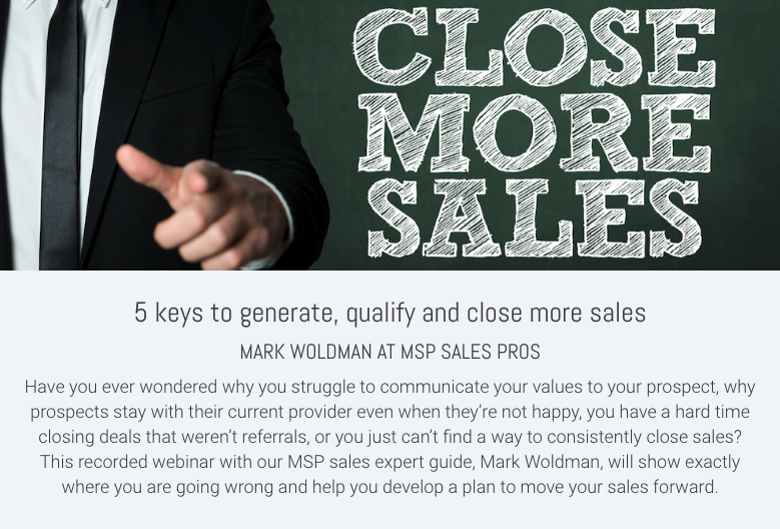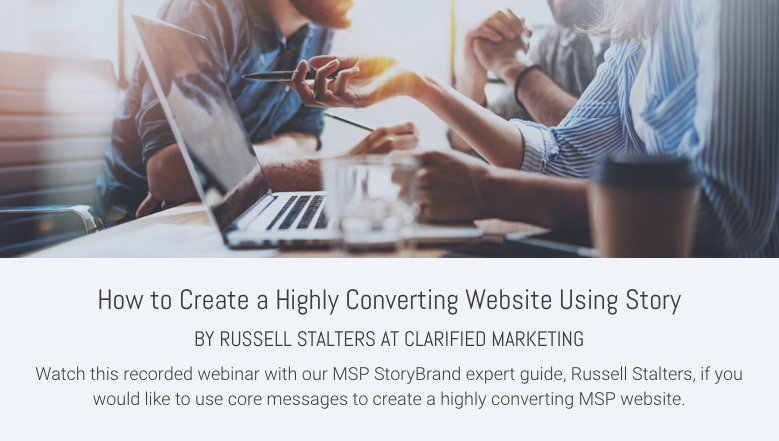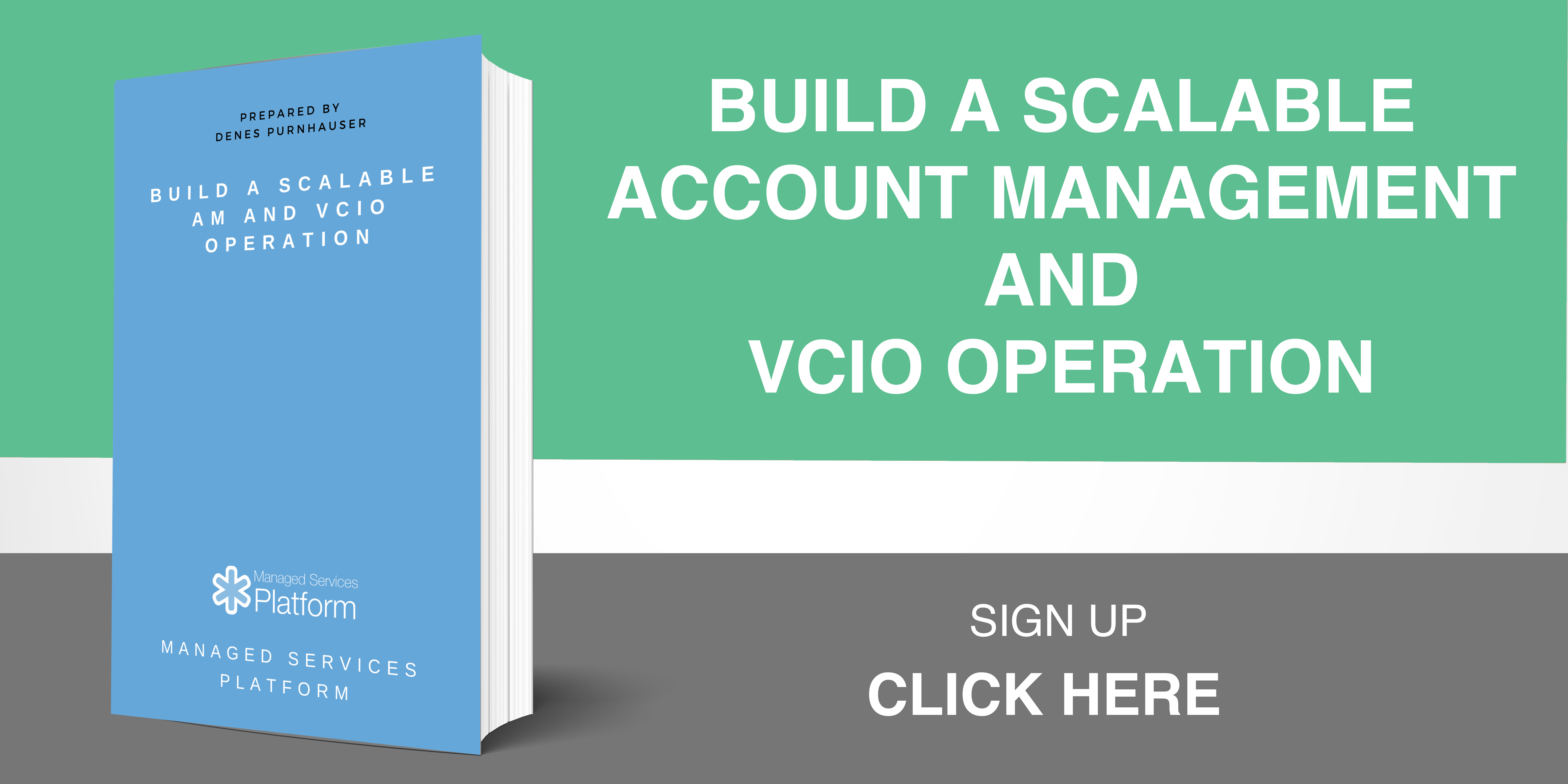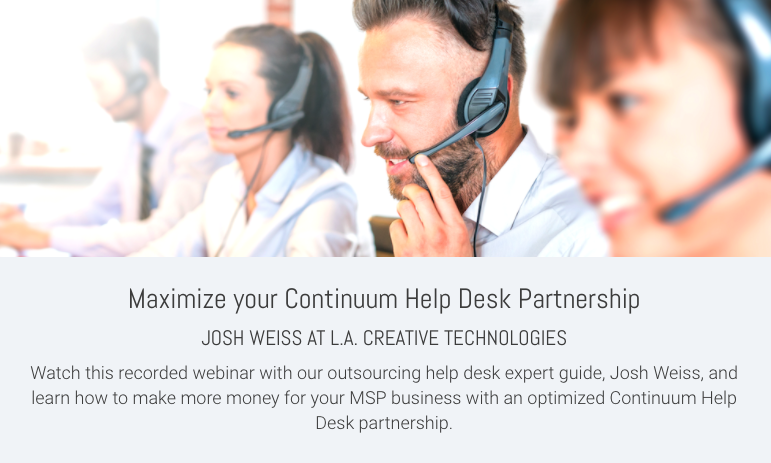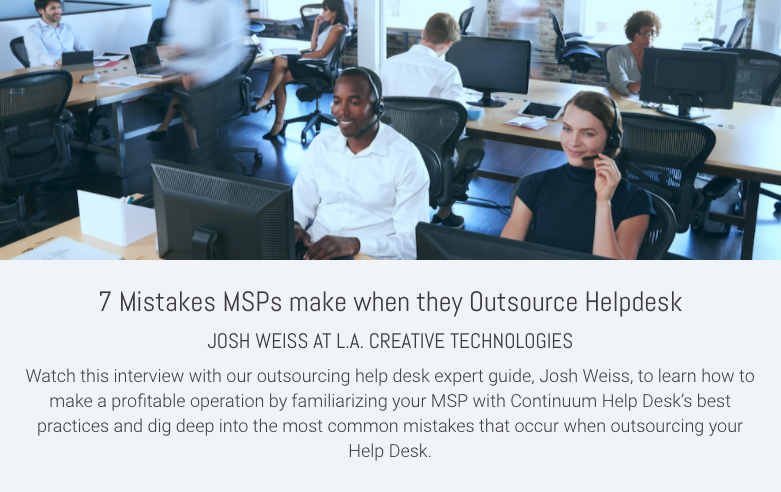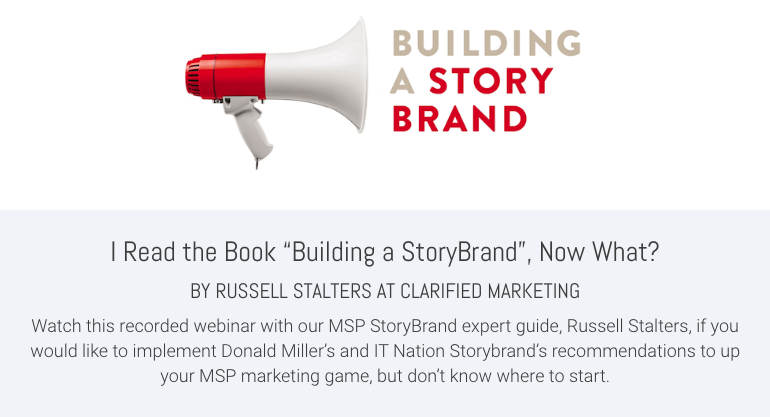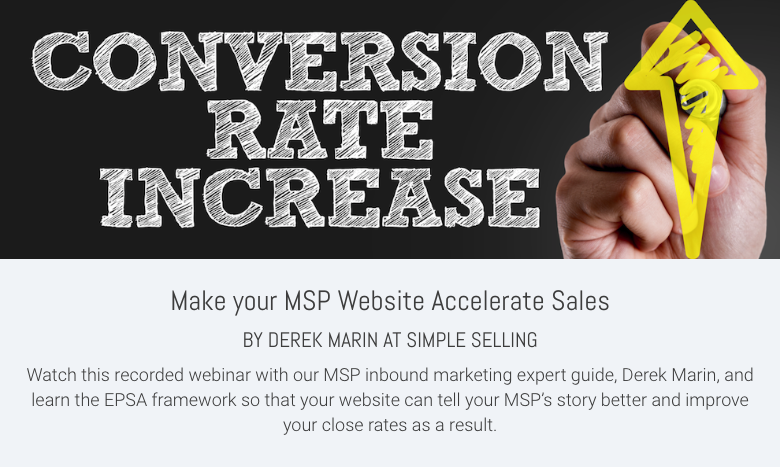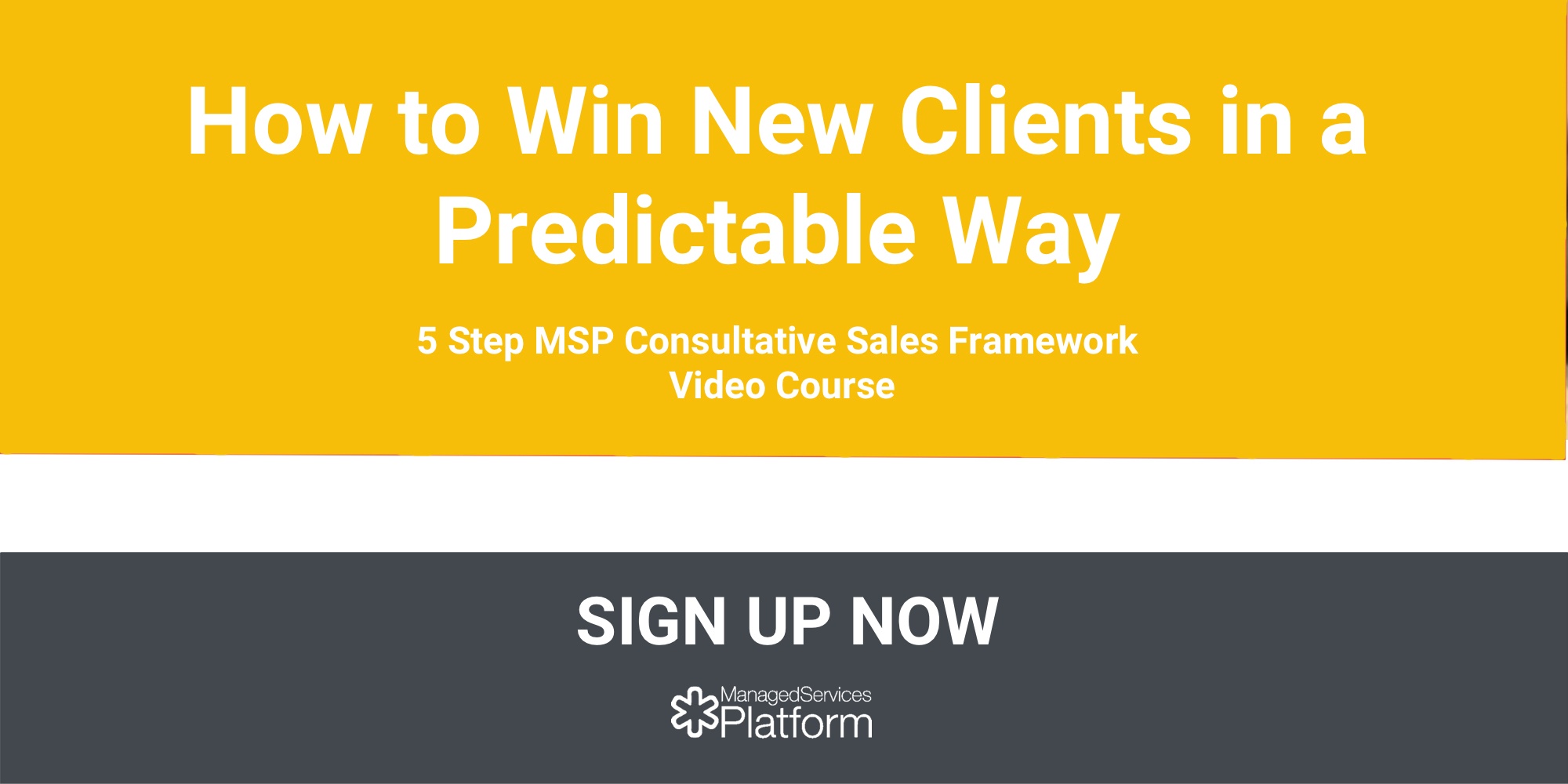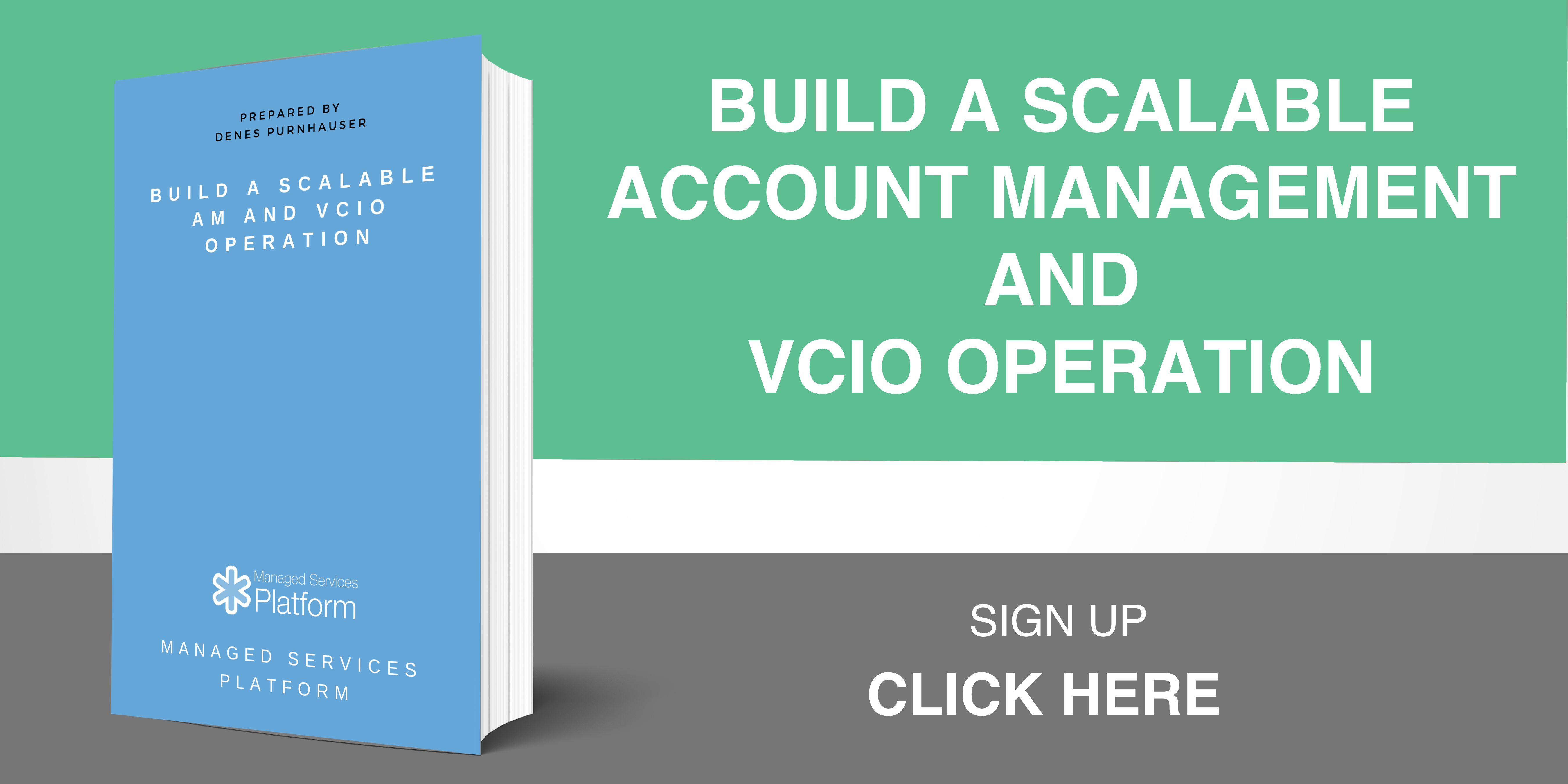5 Reasons You Lose Deals to Your Competitors
By Mark Woldman on October 18 2019
Are you struggling to sell Managed Services?
If you are struggling to sell services, don't worry, you are not alone. MSPs of all sizes are feeling the pinch when it comes to sales, so this struggle is not exclusive to you.
Factors such as increases in competition, frugal clients, poor product positioning, diminishing referrals and lack of overall strategy, cumulatively contribute to a continual decline in sales.
Leads are at an all time low and the cost of generating leads is at an all time high. In light of this, it is more important than ever to utilize ways to set yourself apart from the crowd, secure your role as an industry expert and thus, gain credibility from existing and future clients.
With referrals being fewer, and certainly further in between, it is increasingly harder to grow your business with any sort of consistency. And, SMBs are bombarded with sales and marketing messages from IT companies every day, making it increasingly difficult for you to land meetings with qualified companies.
This makes it imperative that you find a way to stand out from the competition and find a way to convert leads into clients. If you look like the current IT provider or, just like every other MSP out there, with similar service offerings, you are virtually giving the prospect a reason to buy on price.
If you want to put an end to the dreaded ‘Lead-Proposal-Closed Lost’ cycle you will need to become more effective at creating the vision of a higher value experience and demonstrate you have the ability to deliver that experience.
Does this sound like you?
"We'll be just fine once we find a way to get in front of more prospects." While this sounds logical, nothing could be further from the truth. Even referrals do not have the high close ratios which we came to expect for so long. And, leads generated by your own efforts are much more skeptical, with the industry average close ratio well below 30%. Because of this you must have a strategy and a process that sets you up for success.
DIFFERENTIATE YOURSELF FROM YOUR COMPETITION AND
BECOME SALES READY IN 30 DAYS
Unleash Your Growth Potential
By Denes Purnhauser on October 11 2019
Whether you’re a “one-man-band”, an emerging MSP with a handful of people, a team about to reach the 20 people mark or even a large 50+ organization you have one thing in common: you may have reached a growth plateau and want to unleash your potential to get to the next level. In hindsight you can recognize that it all comes back to bottlenecks in your organization’s capabilities to unleash those potentials role by role: Account Management, vCIO, Technical Account Management, IT Sales, Cyber Security and even the owners. All of them have low-hanging-fruit opportunities and by snagging those you can get to the next level in a smooth, predictable way.
Understand your Untapped Growth Potential
Let's first check your company roles and how they can be bottlenecks in your growth.

- Account managers are not providing a predictable stream of projects and cannot support a steady cash-flow
- vCIOs are not upgrading clients to strategic-business vCIO services and cannot get paid by clients
- Technical Account Managers are not adopting new technology standards and cannot set the base for efficient service delivery
- Owners are not setting proper structure for AM/vCIO and cannot keep the team accountable
- Sales People are not getting in front of ideal prospects and cannot differentiate themselves from the competition
- vCSOs are not upgrading clients to modern cyber security services and cannot get paid by clients
You might be a small company and you as the owner might be wearing all of these hats. If you had to choose only one, which would be the most important?
Unleash your Growth Potential one role at a time
Working on every role at the same time will not let you focus or ever achieve a breakthrough. Pick the "rock" you want to work on during the specific quarter and focus on that role. Here are some examples how:

Watch the complete seminar to learn how to unleash your potential with different roles in your organization. Expert guides will walk you through making it happen.
- How to grow with Account Management: Sell High-Value, standard projects with a proactive process by Myles Olson
- How to grow with vCIO: Drive Strategic Conversations and take on the execution by Adam Walter
- How to grow with Technical Account Management: Develop Technology Standards and Adopt them with all of your clients by Skip Ziegler
- How to grow with Sales: Generate qualified leads and differentiate with client experience by Mark Woldman
- How to grow with Cyber Security: Make cyber security make sense to clients and offer packages they can buy by Caleb Christopher
- How to grow with Focus on Execution: Create structures for AM/vCIO, keep the team in focus and ensure accountability by Elissa Kulczycki
How to Unleash your Growth Potential
The traditional way of developing a company is to develop best practices, implement those to the normal daily life and keep vigilant with them during the day-to-day operation. As you have no resources this leads to bursts of projects without sustainable outcomes. Think about why the six roles of your company still have bottlenecks.
Your potential of growth depends on three things:
- Your Talent - the strengths of your team
- Experts help you - people can take the workload from your shoulders
- Tools help you - applications can offer you a productive framework and streamlined execution
By building your MSP with Expert Guides and Purpose-Built Software you will drastically cut the time to success. This will help you to leverage your current resources to break through the barriers and stop spinning your wheels.
5 Steps for sustainable growth
Growing your business can be accomplished through a series of quick high intensity bursts, but will manifest in unsustainable growth with short peaks of results. We want to make sure you have a long-term vision, and can break down the big rocks to stones you can deliver. Those big rocks don’t fit through your system - fix the bottleneck and keep it sustainable. Then move your attention to the next goal but build on top of the previous efforts.

- Platform Orientation Meeting - if you have no membership yet, let's start exploring your goals and discover how the platform might serve your growth
- Growth Readiness Assessment - assess your readiness of growth and identify the bottlenecks holding you back and preventing your breakthrough
- Smart Growth Action Plan - build a SMART goal and plan your next steps to achieve those goals with an action plan
- Execute your Rock - do it by yourself, pick an expert guide's education or engage with a 1-many or 1-1 program to push things through
- Repeat - Go back to the drawing board, choose your next goal and execute the rock of the next quarter....
Conclusion
Regardless of your company size you always have growth potential. By identifying the low-hanging-fruit with one role, you are able to generate the momentum and the positive cash needed to fuel further growth. Being more conscious, focusing on one role at a time and making sure the role will stay sustainable will deliver a compounding positive effect over time.
How Do I Get Visitors to Engage with My Website?
By Russell Stalters on October 8 2019
How to Do I Get Visitors to Engage with My Website?
I mentioned this in my last Blog post. We live in a very “noisy” world and we need to grab their attention in less than a couple of seconds.
This is true for our website too. People don’t read website content any longer. When someone lands on your homepage they will start skimming the page very quickly to decide if they want to spend more time diving deeper.
“But, they went to my page because we met at a networking event!”
It doesn’t matter.
You have 5-8 seconds to capture their attention. Studies have shown that on a computer web browser people scan the webpage in a Z pattern. Left to right across the top, then down to the lower left and across the bottom of the page before they start scrolling down. We call this area before they scroll down “above the fold” which is an old newspaper term.

So, how do we grab their attention?
When they land on the homepage we have to instantly answer three questions…
- What is the big problem you solve?
- What will my life look like after I buy your product or service?
- How do I buy? or What is the first step in the sales process.
Once we have them hooked and our visitor decides to scroll down we need to tell a story.
Not our story or the story of our company. We need to invite them into their story. A story of transformation.
One of the best ways to create your customer’s story of transformation is to use the StoryBrand methodology as described in Donald Miller’s book “Building a StoryBrand: Clarify Your Message So Customers Will Listen”. As a StoryBrand Guide I help MSPs implement the StoryBrand methodology to attract their ideal clients, get more meetings, and grow their business.
During this session I will provide a blueprint for creating a highly converting website homepage. He will share best practices on how to implement the recommendations from the great book, “Building a StoryBrand”.
I will also provide live feedback and improvement recommendations for attendee’s websites during the webinar.
So, make sure you register here and be ready to get feedback on your website.
How you steal money from your own MSP and how to stop doing it
By Denes Purnhauser on October 4 2019
Unfortunately this is not a cheap cliffhanger title just to grab your attention. You’re reading it on your mobile so I’ll be brief like a bumper sticker: you steal money from your own MSP because you address the symptoms of problems with tactical Bursts of effort. That only generates more work and expends resources to generate tiny bits of unsustainable value. Sure, you feel busy and productive, but you don’t solve the problems in the long run. Sound familiar? Let's take an example and see how to fix it with Smart Goals and an action plan.
We’ll go through this process by analyzing a typical MSP use case: Account Management.
1. Focusing on the symptom instead of the root problems
Say you go to a client meeting that doesn’t go as planned. Maybe the client was not engaged, they did not seem to value your services, they weren’t interested in the next project you offer or were simply looking for a price cut of your services.
You come out feeling "we are no longer relevant", "our competition is stronger", or “we need a better QBR process". These are not the root problems to solve - these are the symptoms.
2. Focusing on a tactical solution
Now you feel you should take action and start browsing the net on how to conduct a better client meeting and become more relevant.
You check out some software applications and spend some time evaluating them, download templates, figure out the best processes and talk to peers about how they do their client meetings.
You land a software package, the team is happy and feel the solution is on the way.
3. Premature scaling:
As you execute the implementation you start to see the big picture and imagine how you’ll be doing 15 QBRs monthly for your 45 clients. The challenge becomes terrifying - the amount of activities and tasks to get done, all the preparation and connecting the dots. You start working on processes, customizing collaterals, and working on the process day and night.
Then time goes by and a handful of meetings is done; the team feels this is way too much effort for too little gain and loses momentum. The team finds another urgent project to work on and suddenly the QBRs fall by the wayside, and client meetings are not delivered.
Does this not describe what’s happening with your MSP? Let's go through this list...
- Why did your vCIO initiatives, IT Strategy Services and monetization of IT consultancy never take off?
- Why can your Technical Account Managers not communicate the increased values to clients and you find clients don’t value your services anymore?
- Why is your team still addressing the noisy clients rather than focusing on the high value clients with opportunities?
- Why can’t you get in front of new prospects and close high-value opportunities in a predictable way?
- Why do you cover the increased costs of IT security services in your MSP package rather than monetizing on IT Security as add-on services?
This is not your fault... this is a common symptom of what’s missing - a strategic approach to make improvements in your company.. Let's try another spin on this story:
1. Analyzing the symptoms but working on the root problems:
You go to that client meeting which did not go as planned. The client wasn’t engaged, didn’t seem to value your services, and were only interested in a price cut and not your next projects.
You go back and think it through and you realize that your service company has no Client Engagement "Department" at all. No foundations, no client segments, no roles, no playbooks defined and clients are generally served in a technical/tactical level but are not managed in a strategic way. Holy smokes, we need to do something.
We need to define the complete Account Management program and create resources to get somebody to run it!
2. Set a Smart Goal for a focused Burst:
We need a Burst of effective effort which will start the process in a low maturity setting and help us generate revenues to make it sustainable, work on the system and fine tune it. The goal, however, is not to get it perfect right away, only to start it and get momentum so you can set the foundation to fix it in the long term.
Set a Smart Goal for the quarter: "Increase Project Revenues by $100k in the next 90 days". We do not say "do a better QBR" or "Structure Account Management". We say something quite specific that we can achieve if we reverse engineer the goal to manageable pieces. Like doing 10 QBRs and landing $10,000 each. Now we can focus on the best course of action to land $10k on each QBR. This is actionable, feasible, and the team can actually get results AND develop the process at the same time.
3. Execute the Burst with the end in mind:
Now we have a plan, so we can work on the details that will generate momentum. We’re going to use the Burst of effort to generate as much value as we can with the limited resources we have. But we’ll focus on revenue generation which will be used to create the resources for the higher maturity operation later.
- We deliver QBRs to 10 clients who have security and infrastructure technology debts.
- We generate project roadmaps focusing on security and infrastructure averaging $10,000.
- We list 5 -10 low-hanging-fruit projects and customize our collaterals to focus on selling only those items to make the process simple enough.
- We run a high-value client meeting that results in agreement on the relevant projects.
- We do not customize, do not try to build a rocket ship and we do not automate... just ship it.
4. Create a machine to grow the momentum:
Now the Burst of effort was intentionally "immature", "simple", "minimum viable" or "beta". Why? Because the goal was not to fix symptoms but to be able to create capacity for delivering the required client engagement activities, introduce the concepts to clients and test the waters before we scale anything. We do not have an integrated approach, things are clumsy internally but the client facing part is optimized.
- We use the projects to get some breathing space and positive cash-flow,
- We refine the process and start customization and automation,
- We build on top of the foundation of QBRs and start conducting them regularly with lower value clients, and
- We introduce new ideas and new outcomes for each new QBR and start adding new tools like plans, budgets, roadmaps and so on.
Conclusion:
Creating Smart Goals for a conscious Burst of effort with the end in mind and generating the capacity to put the process to the next level is a way to actually create something sustainable.
Without Smart Goals and the quick Burst, followed by no execution machine our initiatives, all we’ll become is noise makers, never taking off and not generating value within our MSP...like stealing money from ourselves?
7 Smart Tips to Maximize Your Continuum Help Desk Partnership
By Josh Weiss on September 18 2019
After my business grew from a break/fix it tech provider to a full fledged MSP, it was clear that I needed to offer 24/7 Help Desk service. I weighed the options and decided to outsource this role, choosing specifically to partner with Continuum’s Pittsburgh team. This partnership has thrived for the last 4+ years, expanding to encompass our Server Management, Security Operations, Network Management roles and more.
But, even though Continuum is an excellent partner, I learned the hard way that outsourcing a core operational process, like a Help Desk, can not be treated like ‘set it and forget it’. There are instances where it will not fulfil your needs... where you have to tailor it to fit your business. I also learned that the only way to take advantage of all that it offers is by first understanding how it works. It took me years and many mishaps to figure that out.
Outsourcing your Help Desk, easy? Sure... but not so fast!
Let’s get right to it. Here is the issue. Most often, your Help Desk is not integrated or responsive to you and your company’s needs. Certainly when I started, mine was not. I learned the hard way. You don’t have to. Here are 7 tips that will help you Maximize your Continuum Help Desk Partnership. And yes, the devil is in the details.
1. A Good Client Communication Strategy
Be sure to communicate to your clients the REAL benefits of working with a partner like Continuum and their outsourced Help Desk team. For example- they will have a Help Desk service even if Los Angeles gets hit by a missile. Their documentation and data will be safe with a company who can support their business, no matter what disaster might arise. Smaller companies simply can’t provide needed SLA’s without scalability. It’s not only important to share the REAL benefits but also to describe exactly what the Help Desk does, putting all that into a framework and a language that clients can understand.
2. Have Checklists for Complex Tasks
Complex tasks require that the partners have a process in place to keep mistakes at a minimum. The mistake many MSP’s make is not having an actionable process in place for all partnership activities, allowing all team players to understand the process... no matter where they are located or if they are new or old timers. Plus, what is sent to the team is both easy to understand and visualize, making what needs to be done very easy to assign work back and forth, no matter the complexity of the issue.3. Virtual Team Collaboration Process
This is more about collaboration. We already set the stage with proper communication strategy with the client. and managing complex procedures. The third one is about how to manage collaboration, as well as the process itself. First remember, the guys and gals at Continuum are real people.. not automated processes and they must be treated with respect. So instead of just creating a ticket with no communication why not actually talking to them. Ask real questions to help the process work smoothly kie- “Hey, can you tell me if this makes sense? Can you tell me if what I've assigned is correct? Can you make sure that you do this part and then you send another part to a different team?" Many call this team building, I call it collaboration and treating all members of the team as equals no matter where they are located.
4. Tactical Overview
This fourth tip is about having the proper tool set versus not having the proper tool set. Anyone who runs a MSP knows you need to have the right overview of your processes. In the case of the Help Desk, there's a couple of tools that have been really helpful in keeping control of the tickets.
For example, instead of only using ConnectWise which has terrible visualization tools, we use a BrightGauge dashboard that we developed for the purpose of watching our tickets, which are on our help desk board. This is a board that excels at maintaining accountability with our partners in the help desk. Basically we created more of the tactical layer above an operational stack, which has helped us to see what's going on on the higher end.
5. Quality Assurance
The fifth tip has to do with having a solid QA process. Without quality assurance, the chances for mistakes quadruple. I cannot stress this enough. If you are not triaging, managing, and doing ticket closing, you're going to have dissatisfied customers. It's just that simple. And I've never been taught this by any outsourcing partner. This is something I had to teach myself.
One of my colleagues lost a $3,000 a month MSP client last week. One of the major reasons was because tickets were just sitting unattended in Continuum boards, and everyone in their company thought they were being worked on. The solution- Watch things, read things, pay attention. You need to know what's happening. You don't want to go to a QBR and have someone bring up a ticket and you don't even know what the hell happened. You don't even know it existed. Just because you are outsourcing your Help Desk does not mean you should ignore it or not integrate it into your entire company.
6. Know your Partner’s Limits
You might think this is just obvious, but its importance sometimes gets forgotten. You must understand the limits of your outsourced partner.
For example, in any Help Desk process there's a knowledge transfer and without a proper knowledge transfer, the tech team might get it wrong. Plus sometimes there are certain tools better managed by the MSP itself. Basically you have to understand the limits in a capability sense. Do they know how to follow the instructions that are provided? Are the instructions even provided? Do they have access to the system that's in place. Do they have the personal skills to deal with clients? There's so many things from a technical standpoint that must be shared, let alone, the human perspective, it is wise to be clear when your Help Desk should handle something or when your internal team should.
7. Building your company culture- Help Desk and Internal Staff as one
This is to counter the last tip. The last tip is about not understanding the limits of your outsourced Help Desk team. This tip addresses leveraging the collaboration strategies that we mentioned earlier. It's about teaching everyone on the team how to delegate. I'm telling my guys, “you have these partners,” right? Maybe it's the help desk, or maybe it's, “hey, I need you to troubleshoot this server issue overnight.” But again, the cultural piece of outsourcing is teaching your entire team to know how to delegate. That's one of the biggest pieces of building a strong and aligned team.
There is a cultural shift when you can build your virtual network of resources that everyone can use. We're trying to expand the scope of what people do, but it's almost like everyone has to become a little bit of a manager. You have to learn how to see what's happening in a ticket, and how to know what are the limits, but also what are the possibilities with these partnerships? One team looking out for each other... having each other’s back, that is a successful MSP.
Conclusion
Your Continuum Out-Sourced Help Desk supports MSP's by providing superior helpdesk solutions. If handled the right way, it can act as a direct extension of your business. That is why your Help Desk should be utilized as a true partner... so you can offload the tasks that are holding back your business. But as any successful partnership, don’t just ‘set it and forget it’. This partnership needs effort and attention on your part to make it a REAL success.
How to Make Managed Service Provider Marketing Better
By Russell Stalters on September 11 2019
Here are two ways to make your making better.
Managed Service Providers (MSPs) most often have really complex solutions. One challenge most people in the IT industry suffer is the “curse of knowledge”. The term was coined by Chip and Dan Heath back in 2006 and then they wrote about it in their 2007 book, “Made to Stick: Why Some Ideas Survive and Others Die”. Later, Lee Lefever described practical ways to combat the “curse of knowledge” in his book “The Art of Explanation: Making your Ideas, Products, and Services Easier to Understand”. I highly recommend both of these books to anyone who is marketing and selling IT solutions.
With the curse of knowledge, we know our product or service so well we have a difficult time imagining what it is like to not know it. This seems to be especially true with technical fields and IT professionals. Our technical and inside knowledge interferes with our ability to see the world from another person’s perspective. We wind up talking over the heads of our customers.
Remember we live in a very “noisy” world and we need to grab their attention in less than a couple of seconds. This is an area that many of my clients struggle with.
On a scale of 1 to 10, where 10 is the complexity we as MSPs live day in and day out, and where 1 is super simple, we need to be at a 2 or 3. Most of my clients have their marketing “dumbed down” to a 7 or 8 and our customers will be attracted to and understand messages that are at a 2 or 3. The good news is that after you work on simplifying the way you talk about your solution to your customer’s problem, customers will listen.
We live in a very distracting world. One of the other ways to cut through the noise is through story. Think about it. Until the printing press and the proliferation of books, story was the primary method of communication and passing on information. Story helps cut through the noise by organizing information in a way people will listen. Facts, figures, and features are boring.
Neuroscientists estimate humans spend more than 30% of their time daydreaming. Think about the last time you watched a great movie with a great story – were you daydreaming? We can use story to help our customers see how we can solve their problem and what their life will look like after they buy our product or service.
A list of features or benefits by themselves will not sell your services. Use a story of a customer’s journey from frustration and challenge to success with your solution and services. Every person intuitively understands a good story and is working at living her own story. If your business could understand the story your customers are living in relationship to your brand, you can stop selling products and services and instead invite customers into a story. Their Story. By positioning your company as the guide in your customer’s story, you can more easily speak to your customer’s needs.
One of the best ways to create your customer’s story is to use the StoryBrand methodology as described in Donald Miller’s book “Building a StoryBrand: Clarify Your Message So Customers Will Listen”. As a StoryBrand Guide I help MSPs implement the StoryBrand methodology to attract their ideal clients, get more meetings, and grow their business.
Make Your MSP Blog a IT Sales Tool
By Derek Marin on September 6 2019
Okay, you just exchanged business cards with the owner of an accounting firm during a chamber event.
He said, “Sure, let’s plan on meeting some time over the next 2 weeks.”
Awesome! You left the event with a qualified lead! Plus, he agreed to meet and he already shook your hand.
The problem, because we all know it’s never that easy, is that there’s a delay. You couldn’t ask him much of anything, and nevermind describing what makes your MSP unique.
There’s no set date for the appointment, and who knows, he may bump into a competitor or research online in the next 10 days!
So, what do we do now?
You need to activate the EPSA campaign
EPSA is an acronym for education, professionalism, story-telling and authenticity, and together, these are the qualities you want your prospect to understand, because if they grasp what makes you and your company unique, your chances of winning will go up.

The full implementation of EPSA is what I’ll cover in the seminar, but for this blog, I’ll share just two examples of how MSPs are doing the “E for education” part of the EPSA methodology.
E is for Education
Let’s get back to the story above.
The CEO of that accounting firm may have asked you a question about security, or maybe they told you they were using O365 but not getting much out of it, or perhaps he didn’t say a thing aside from “we need help with IT.”
The goal with the E part, or “education,” is to teach your qualified opportunity two things. First, to teach him something he didn’t know, and second, to show him that your company is a thought-leader.
Example by NSI

NSI is an MSP in Naugatuck, CT, that my agency helps with sales and marketing. A blog called, “In the Trenches of a Real Breach” is an audio interview we did with Tom McDonald, the CEO, about some ransomware attacks. It goes into what a SOC is and the importance of having an incident response plan. By having Tom’s voice and real story, we are showing his unique expertise.
Example by Casserly Consulting
Casserly Consulting is an MSP in Boston. A blog called, “The State of Cyber Security in the Commonwealth” we took the publicly available breach data from Mass.gov and we analyzed it. By doing a deep dive into the nature of breaches in Massachusetts, we’re making Peter’s MSP a thought-leader.
Productized IT Strategy Guidance to clients and prospects
By Denes Purnhauser on February 23 2017
We had a great debate in our Banff Workshop about timing one’s IT Strategy correctly when meeting with new prospects. Some people were adamant the IT Strategy meeting be a requirement to even sending a proposal, while others were more inclined to implementing an IT strategy creation process after the onboarding, after we fix all the client’s technical issues. This is often the case in a workshop, when everybody was right but in conflicting ways. Let's see how to best approach this question.
Let's put this question to a higher level first. How you are going to engage your clients and lay down a plan for them to raise their maturity over time to create a sticky relationship and predictable customer success? This is the ultimate question. If you can answer this question then you have a foundation for the type of strategic guidance to give.
Generate client engagement
with five Quarterly Business Reviews (QBRs) in 30 days
Usually strategic guidance services are upfront projects to help you differentiate yourself, get to know the client, create momentum and foster engagement, so it is critical to manage it well. If it’s productized then most client expectations will be set right upfront, or well managed over an annual meeting.
First of all IT Strategy Planning is not a commodity, so let's first define what we mean. IT Strategy is a written document with a specific scope and depth. IT Strategy can be notes on a napkin with goals and major initiatives or dozens of pages supported by hours of research and meetings.
Another complication: your prospects/clients have varying maturity levels in terms of management and technology. A napkin plan doesn’t give so much value to a high maturity client and a 100 page IT strategy does not make sense to a twenty-person old-school local travel agency.
The right answer, of course, is nuanced: create different productized IT Strategy Guidance type services for managing these different situations.
We defined three different productized services to be able to sell to the typical small and medium enterprises. These are scalable - all have the same basics, and are more modular than LEGO bricks. If they’ve outgrown the first they can upgrade to the second just adding more bricks.
1. IT Discovery Service
2-4 hours of commitment gets the deliverable of a standard report with a standard template-based action plan focusing on their IT infrastructure. This is ideal for a low maturity prospect so we don’t take up too much time as well as out of the budget. We can still differentiate ourselves with professional results without overwhelming them with details and terms they don’t understand.
The outcome is typically a report generated by a questionnaire and some additional analysis by you. The report is more of a guidance for the conversation and helping make decisions faster.
That should be part of the Account Management process we include in our services and part of the sales process free advice.
Many of our clients use this approach for making account management more of a value-add rather than a "salesy" item, and to set a stage with any type of prospect.

2. IT Development Roadmap Service
4-8 hours of commitment and the deliverable is a customized roadmap focusing mainly on the infrastructure components and major initiatives listed. We add a bit more meat to the outcome with a structured plan outlining the initiatives and time frames. This takes more research, effort and consultation, but the basics are the same.
The outcome is typically a spreadsheet called IT Development Roadmap, with the plan items elaborating more on the report.
That can be a part of a vCIO Light / Client Advisory service and charged separately. to our existing clients every year ($1000 - $2000) as a project. The reason for this is if they have no room in the budget for that we can create this for free, but since they’ll have no money for the projects included with the plan anyway, this is a great qualification. If we have a low maturity client this can be their guide for the next steps after onboarding. It’s a good idea to charge for that, but give them a huge discount as new customers.
A client of ours uses this approach to set an 18 month roadmap with a new client, to transit them from onboarding to regular QBRs and client management.

3. IT Strategy Planning Service
8-18 hours of commitment with more detailed research for the planning, like business discovery, more in-depth research and better specification of initiatives. More time is spent on scoping the initiatives and liaising with various stakeholders to produce a decent operational plan with activities and budgets.
The outcome is usually a Strategy Plan with the report and development roadmap adding the project definitions and more business-related items.
Now we’re working on their business; we listen to different people, scope projects together and help them set projects for a variety of initiatives. That’s usually part of a basic stand-alone vCIO Package we sell for $1000 - $2000 monthly. However as a project it should be sold around $2000 - $4000, depending on your approach. In many cases this is an awesome service to throw into the sales process when dealing with a high maturity prospect. Usually their infrastructure is not in need of fixing, so it’s hard to beat the incumbent without a major price discount. But defining yourself more as a consultant and someone who understands business can pay off.
A client of ours uses this approach to actually qualify the prospects. They don’t sell to a company who won’t pay $4500 for IT Strategy. They’re looking for a few high level, high maturity and high value clients - not a lot small ones.

Conclusion
If you have multiple types of projects upfront with Strategic Guidance you have more options to engage current clients and to close new ones.
Based on maturity you’re able to apply services in different scales. In engaging prospects this gives you the flexibility to break their buying cycle and apply your sales process, and close deals faster. For existing clients you can qualify them for more advice, and politely disabuse them of the notion that your advice is free.
Service Productization has a great value this is only one place of your service offering it can be applied.
Systematic service development process
By Denes Purnhauser on February 17 2017
One of the hot topics in the bootcamp was a typical MSP issue - managing client agreements. The problem gets verbalized in different ways: "I have many new services I would like to sell to existing clients" or "I have to re-onboard all of our customers because the agreement is very old" or "I want to increase our prices to reflect the improvements and additional tools we introduced" or "I barely make any money and I need to renegotiate our prices". Sound familiar? We’d like to introduce a systematic approach to solve this problem for now and the future.
What is the real underlying problem
The original problem is nothing more complex than the ad-hoc and un-managed service development process period. As a service company you spend a whole lot of time developing your services. All internal processes are service development, all tool deployments are service development, all new vendors are service development...meaning everything you do that isn’t providing a service to a client is you developing your services. If you do that without any control mechanisms the result will be misalignment with clients.
We all know that service development doesn’t happen without reason. The technology is always changing, the market needs new services, old services become obsolete, clients come and go, and new opportunities arise. As a managed service provider, a plethora of moving parts to deal with can result in less profitability, under-utilized services and obsolete agreements. The usual solution is to spend more facetime with clients and explain, negotiate, present, and discuss with the owners or account management team why you need to re-align. Sometimes, however, we need to manipulate prices, introduce new services or otherwise change the set agreements.
Solving these symptoms requires identifying the root problem: make the service development, deployment and communication a conscious effort.
Differentiate yourself from your competition and
become sales ready in 30 days
Service Development and Deployment Process
Without going deep into details, let's go through the process quickly. It’s surprisingly simpler than we’ve found most people fear. This is because of the closely related industry with which we face this challenge: software companies. We don’t have to do much more than understand how they’re solving this problem, and apply the practices.
- Roadmap: Software developers have an internal bible called The Roadmap. This document lists out all the changes they have to make in their tool - new features, updates, fixes, internal processes, and everything else. That roadmap is a central element of their efforts, and the majority of their team is guided by that document.
- Agile development: the gist of being agile is not to execute long term plans, but get the most important items from the roadmap and ship a version of them early. That helps get to the endpoint step by step, while giving the customers tangible value along the way. It also helps focus the development effort with (typically) understaffed teams.
- Beta: Sometimes developers will ask you to participate in beta programs, where you get access to improved features faster (and take on the risk of reliability), and they can test out the user experience and further develop the product, validate their ideas, fine tune processes and the optimize the user experience.
- Release: As a software user, and even more so, a cloud application user, you know that applications are changing all the time...not minute by minute while you’re using them, but by release cycles. The development team develops new features, new modules, enhance the UI, etc, and you get it as a package in the new release.
- Upgrade: Sometimes it turns out that the function you just started to use is going to be an add-on or in a higher-priced tier. You still can use the product in the beta period, but you might have a decision to make whether you want to upgrade to enjoy the new features.
To summarize:
- They have a conscious effort to develop their products and services
- There is a guiding document for everyone to be in focus
- There is a mechanism (releases) to deploy and communicate changes with customers
- There is a mechanism (beta) to engage users with the new experience
- There is a mechanism to redefine the offering, giving the customer the option to stay on the current plan or upgrade
So let's put these basic principles into play as an MSP
- Roadmap: as an MSP you need to have a guiding document listing out all the changes you want to make with your services. Internal process fixes, new tools, new processes, new services - everything related to your services. As you plan your development activities the roadmap helps your team to stay flexible while keeping priorities clear.
- Agile development: based on your roadmap you pick the most important developments, selecting what matters most, instead of scrambling to deal with everything on the board. Every week you can have a development meeting and focus your efforts on specific internal processes, your customer interfacing or implementing certain features of vendor applications. That gives your team focus and a sense of accomplishment as opposed to the futility of firefighting on internal projects.
- Beta: you might pick specific clients to enjoy the benefits of new services. You can introduce vCIO, Technical Account Management, Application management or even security services to your clients as a beta program. The process helps you to get their consent of the experiment (and also lets them know development is progressing) and you can offer these new services or updated experiences for free for a while.
- Release: the main thing to consider in release cycles is to minimize internal stress and enhance communication. You can batch many items together and send a quarterly email, letter or a complete webinar to let all clients know about changes being made, and how they affect them. If you provide Account Management, the Quarterly Business Review (QBRs) are perfectly suited to presenting innovations to customers.
- Upgrade: let's assume you made four quarterly updates on your services during the year. You communicated well what’s beta, what’s sustainable fixes, upgrades (which will be part of their current plan) and what are going to be new service line items (extra charge). Typically once a year you can repackage your offering to include all new services to the current packages and also display the add-ons and features they can access if they upgrade. This method of repackaging means only those clients will enjoy the new features and benefits who upgrade. This will be their decision.
Benefits
- proactive process gives you control over your services to make sure clients are seeing the value of your developments and progress
- the roadmap can give you peace of mind, clarifying where to develop, and helping allocate the necessary resources to streamline development
- agile development gives the team clarity - a process for working on your company instead of for your company - crucial to your ability to scale
- the beta can help you develop services with clients without incurring the pitfalls of nascent services
- releases help you communicate changes very effectively without creating confusion
- upgrades help you restate your value proposition every year, set expectations and give your clients a sense of progress and choice
20% rule of vCIO pricing
By Denes Purnhauser on January 26 2017
Here’s a mystery you all know all too well - pricing your stand-alone vCIO services so you’re not robbing your clients nor yourself...that trepidation when you’re putting together the proposal, or trying to ballpark a figure in a meeting. It’s always been a gamble. There’s a way to find the proper middle ground, following a simple process to help you to close more deals without risking a critical over or underestimation, of your client’s expectation or your services. Here is the formula...
We just call it a 20% rule....
The formula is quite simple. We take the client’s current expenses in managed services calculate 20% of it. This will be our baseline for a starter stand-alone vCIO package. Use this as the main rule of thumb, and we’ll take a look at some cases where we have to turn from this calculation.
Example. You’re talking with a 40 person firm eligible for a $125-per-user managed services program. That’s a $5000 MRR for the managed services. With your 20% stand-alone rate the virtual CIO program will end up at $1000 MRR.
Structure, manage and automate
your account management and vCIO procesess
Client point of view
Most often you’re selling the vCIO services as an extension of your managed services, and you’ve seen eyes spinning at the mention of the cost. But you know about the pricing effect: if the add-on service is too small, like 10%, they can feel it’s not worth mentioning, and why isn’t it in the package anyway? If it’s too much, like 40-50%, then it’ll come with the price of a totally different service category. We must keep an eye on our psychological influences.
- 20 % is an easier upsell to an existing company
- 20% is what you can give as a month of free trial
- 20% is what they’ll readily risk for a 3 month trial period
So from a buying perspective, it’s not disruptive, complex, nor risky. It’s the predictably happy medium.
Your point of view
We need to check the viability of this service from your end too. As we design a vCIO offering we must list out the diverse activities which are part of the package, check how frequently we do those activities, and calculate an annual workload, for an honest basis for the price. Usually we use $200 per hour to calculate a monthly service fee. With the 40 person client as an example with $1000 MRR, we’ll see 60 hours budgeted for a year, or 5 hours monthly. That’s a reasonable amount of work for that size of client.
We’ve developed four different vCIO Packages:
- vCIO Light - typically a teaser service at a cost of $250/month to perform, and great for triggering stand-alone services. It’s also good for small companies (check later).
- vCIO Basic - $1000 - $1500 MRR, suited to 30-40 person companies or bigger companies with less maturity. This is the typical bare minimum with no weekly cycles.
- vCIO Professional - $2500 - $3000 MRR, for the 40-70 strong SMEs where you can start to develop seriously and begin to integrate with the management team.
- vCIO Enterprise - $5000 - $6000MRR - when you’re going to nearly substitute a full-time CIO/ IT manager. This is only viable for 70+ situations.
If you’re interested in these packages, make a quick call and we’ll show you the processes, marketing, sales materials, workspaces and all the associated reports and tools we provide for a complete, professional execution.
Remark 1: Projects
Projects are never included with a stand-alone vCIO program, just annual planning, budgeting, some project scoping, some application selection, quarterly planning sessions, monthly reviews and so on. Every project is a separate item. If their IT strategy is to choose and implement a cloud based CRM solution and integrate it with Zapier to their accounting system, that’s a separate project. We can manage it as part of the service portfolio if someone else manages the project. If, however, we’re responsible for the implementation, that again is a separate line item.
Remark 2: Small Companies
As you can see, if you have no budget for at least 30-40 hours of work annually, even at $150/hour (which will end up at around $400 - $500 MRR) you cannot really accomplish anything as a vCIO. The $400 - $500 MRR with the 20% rule will give you the $2,000 MRR MSP service. Even if they have a $100/user rate it will work with a 20 person company. This clearly defines the boundary, that below 20 people there is no viable, profitable vCIO service possible. You can’t generate enough revenue, and the client will have no budget to execute projects. You might quote a $200 - $300 upcharge for "Client Advisory" services to perform the basic Account Management activities like QBR/Annual Planning and some consultation every quarter. Though extremely limited, this is their call. If they don’t want to pay for it, you still can’t do it for free.
Conclusion:
Don’t complicate. If the client asks about vCIO, just say: "Our rule of thumb is around 20% of what you pay for the managed infrastructure services." If they’re not interested to the service with this estimate, there’s no way you can deliver your services viably with a lower price point.
3 previously posted Managed Services Platform blogs about vCIO sales:
- How to Become a Trusted Advisor With Strategic Client Meetings
- Managed Services Platform vCIO Report 2019
- Managed Services Platform Account Management Report 2019
3 previously posted Managed Services Platform research about vCIOs


